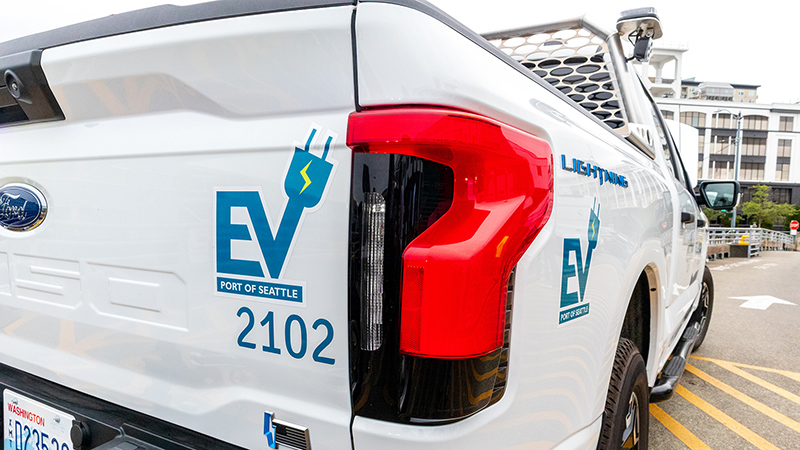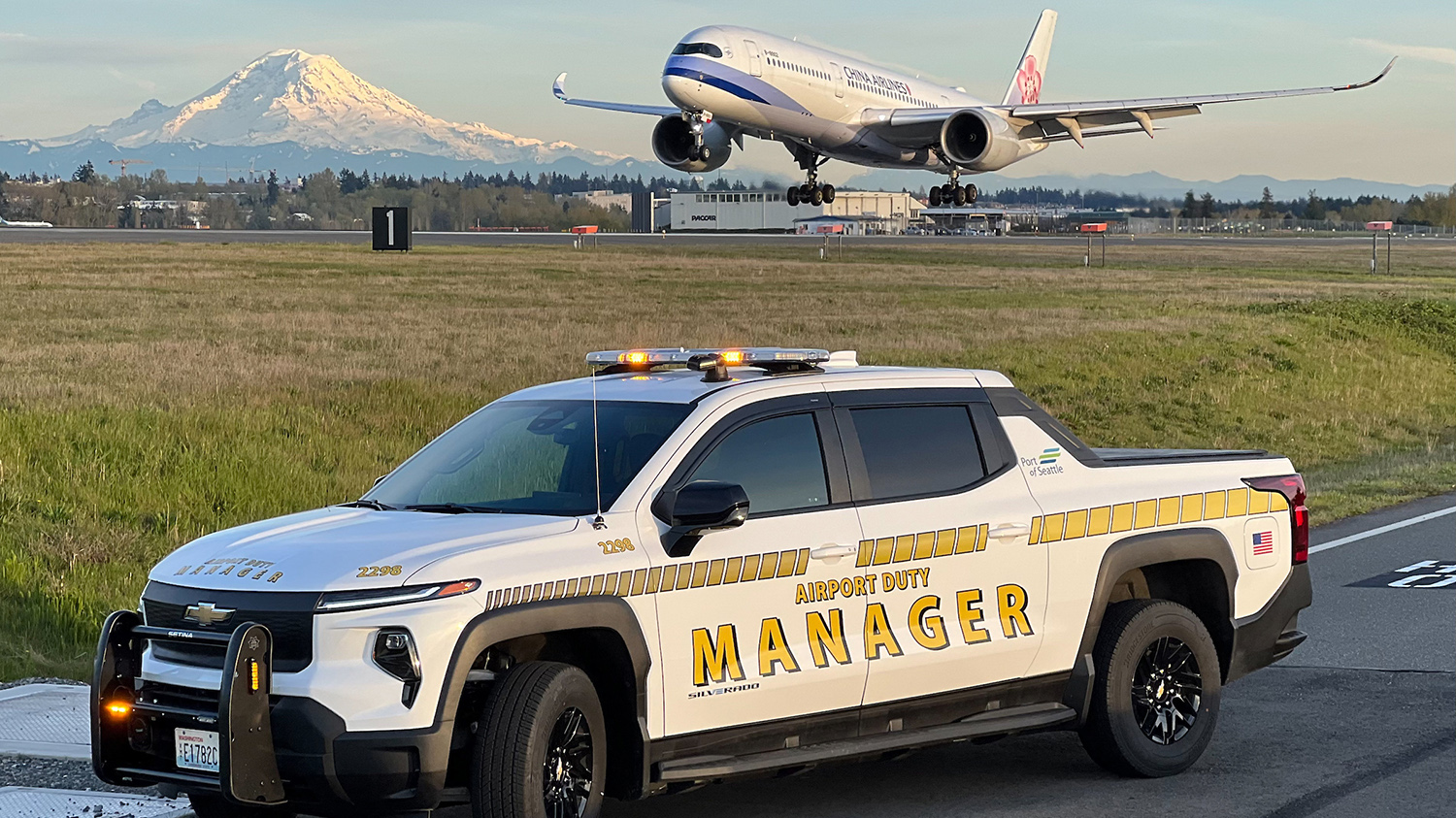Look around Seattle-Tacoma International Airport (SEA) or the piers along Seattle's waterfront and you'll see the Port of Seattle in action. In addition to ships and aircraft, more than 1,500 vehicles and specialized equipment are in use every day to keep the port running, from maintenance vehicles keeping the lights on to heavy-duty forklifts moving cargo.
These vehicles are critically important, but also account for approximately 15% of greenhouse gas (GHG) emissions within the port's direct influence. To address this problem, the port has set an ambitious, long-term vision: to become the greenest and most energy-efficient port in North America, with the goal of achieving a net-zero fleet by 2040.
The Port released the Sustainable Fleet Plan in 2021 to transform the way our workforce moves, from resizing the fleet to transitioning to new electric vehicles. The effort not only reduces emissions, but also reduces operating and maintenance costs along the way – and it takes a lot of planning and preparation to get there.

Optimization and electrification of the fleet
The port's main strategy consists of two aspects: scaling and electrification. The goal is simple: convert all gasoline-powered sedans and SUVs to electric vehicles (EVs) and make the entire fleet as lean and efficient as possible. That means retiring unused vehicles and replacing larger, gas-guzzling models with smaller, more efficient or electric options that still meet the port's demanding operational needs. These targeted efforts are expected to result in a reduction in greenhouse gas emissions of over 2,000 tonnes by 2030.
Transition to electrification
This transition isn't just about purchasing new vehicles; It requires careful planning for the availability of commercial vehicles, securing the necessary funding and grants and, most importantly, investing in the charging infrastructure required to keep the fleet operational.
This strategy is quickly becoming a reality for both light and heavy fleets.
- 12% of the light marine fleet and 8% of the light commercial aviation fleet are now electric
- There are currently 53 electric vehicles in use throughout the port
- A new electric workboat will be launched at Fishermen's Terminal in 2023
- The port secured an $800,000 grant for two electric forklifts at Terminal 91
- A proposal for 29 electric rental buses at SEA Airport is also being examined for a 2030 transition
Forming the backbone: charging infrastructure
To support this growing electric vehicle fleet, the Port has initiated comprehensive assessments to determine the optimal location, type and timing to install charging stations on all Port properties. Extensive infrastructure needs studies for the shipping and airport sectors were completed in 2023 and 2024.
Recently completed charging projects:
SEA airport
- Nine Level 2 chargers for airfield lighting, field service teams and auto repair teams
- 28 Level 2 charging ports in the parking garage for police, security and land-based operations (2024-2025)
Short-term charging installation projects:
Large installations are planned including:
Maritime
- 18 dual-port Level 2 chargers at the Marine Maintenance South facility
- Level 3 high-speed charging ports at Marine Maintenance North and the Maritime Industrial Center
- Stage 2 installations at Shilshole Bay Marina and Pier 66
SEA airport
- Five Level 2 Chargers at the Port of Seattle Fire Department (November 2025)
- Seven Level 3 high-speed charging ports at D-Gates (2026)
- 40 Level 3 charging ports for rental bus fleet (2030-2031)
Sizing Milestones
The simple act of ensuring the Right The right vehicle for the right use has already led to significant emissions reductions:
- Technology department: Reduce the fleet by nearly half, from 86 to 42 vehicles, by removing underused vehicles and switching to a shared-use model (2023).
- Maritime Department: 18 F-150s replaced by more efficient E-Transits or Ford Lightnings (2025)
- Airport teams: The Airfield Lighting group has transitioned from 1-ton pickups to 2025 Ford Lightning EVs, and the Aviation Paint Shop expects to operate a predominantly electric operation by the end of 2025
- Port of Seattle Police Department: The Bomb Unit switched from one-ton pickups to half-ton SUVs; and the administration department replaced large SUVs and pickup trucks with smaller, more efficient hybrid SUVs and sedans
Reduce emissions today with renewable fuels
While the port works to fully electrify its fleet, it is currently using renewable fuels to reduce greenhouse gas emissions.
Renewable diesel and renewable natural gas (RNG) are important near-term solutions for diesel and compressed natural gas (CNG) vehicles for which replacement is not yet planned or for which suitable electric models are not available. The port began purchasing renewable diesel in 2018 and RNG in 2020. In 2023 alone, the fleet used over 40,000 gallons of renewable diesel and 375,000 gallons of RNG diesel.
Using data to improve efficiency
Data is the key to a smarter and more efficient fleet. The port uses fleet technology, such as telematics technology, not only to support right-sizing efforts, but also to make existing vehicles more efficient. This technology helps limit engine idling and provides valuable operational data including speed and fuel events.
In 2024, the port procured a new telematics system that will be installed on 80% of the fleet's assets by the end of 2026.
The journey to a net-zero fleet is complex, but the port's progress in just a few years proves that its commitment to being the greenest port is more than just a goal – it is a reality that is being built every day.
Subscribe to Evergreen for sustainability updates from the Port of Seattle and SEA Airport
